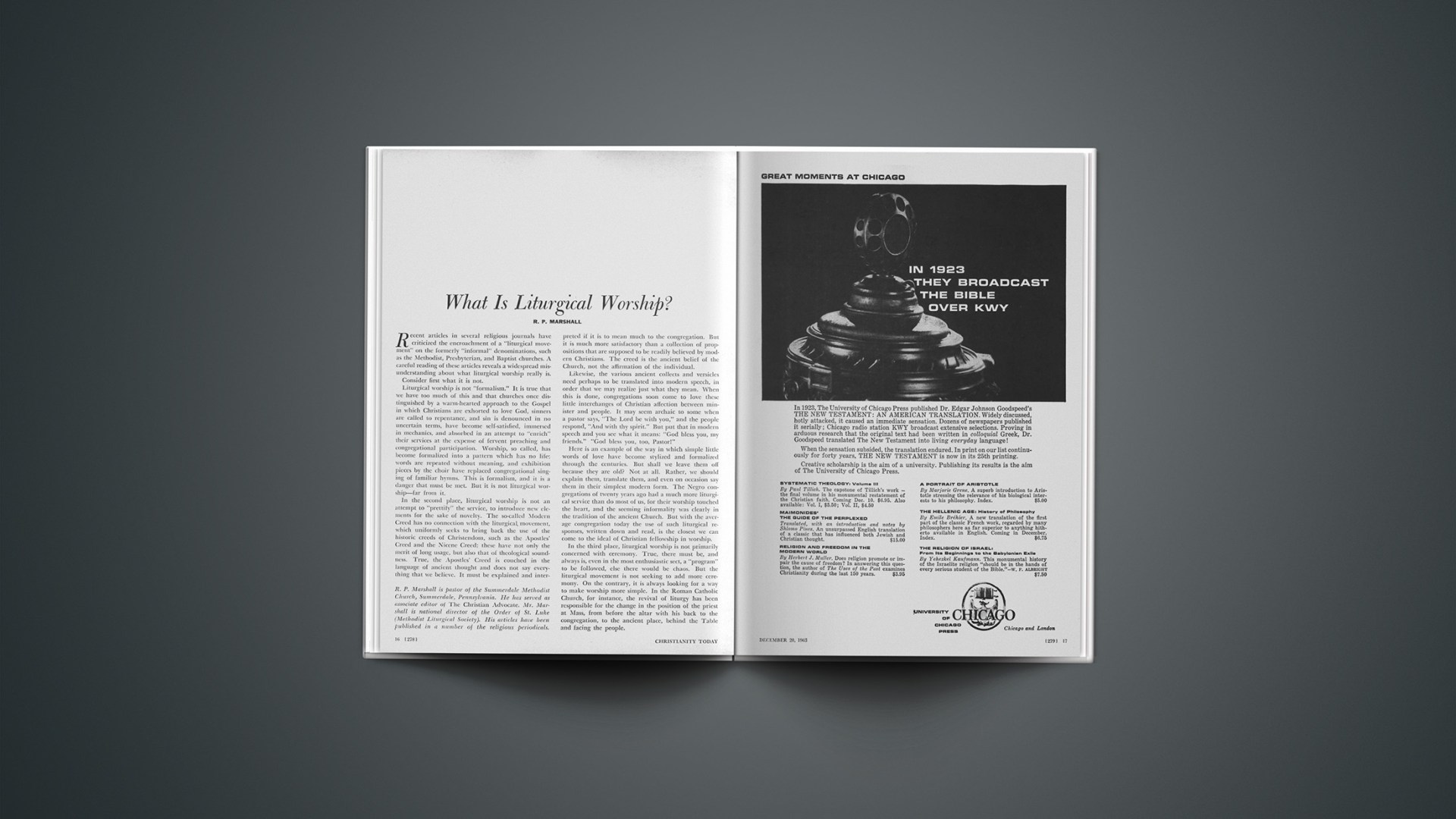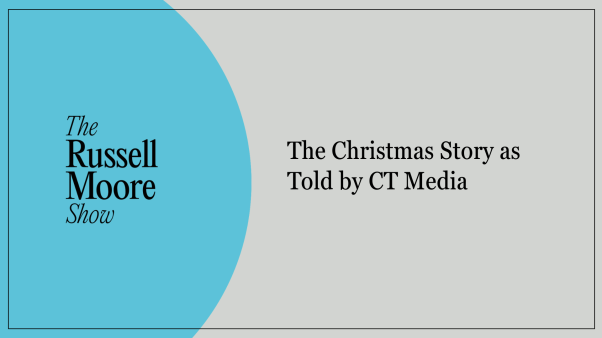Recent articles in several religious journals have criticized the encroachment of a “liturgical movement” on the formerly “informal” denominations, such as the Methodist, Presbyterian, and Baptist churches. A careful reading of these articles reveals a widespread misunderstanding about what liturgical worship really is.
Consider first what it is not.
Liturgical worship is not “formalism.” It is true that we have too much of this and that churches once distinguished by a warm-hearted approach to the Gospel in which Christians are exhorted to love God, sinners are called to repentance, and sin is denounced in no uncertain terms, have become self-satisfied, immersed in mechanics, and absorbed in an attempt to “enrich” their services at the expense of fervent preaching and congregational participation. Worship, so called, has become formalized into a pattern which has no life; words are repeated without meaning, and exhibition pieces by the choir have replaced congxegational singing of familiar hymns. This is formalism, and it is a danger that must be met. But it is not liturgical worship—far from it.
In the second place, liturgical worship is not an attempt to “prettify” the service, to introduce new elements for the sake of novelty. The so-called Modern Creed has no connection with the liturgical, movement, which uniformly seeks to bring back the use of the historic creeds of Christendom, such as the Apostles’ Creed and the Nicene Creed; these have not only the merit of long usage, but also that of theological soundness. True, the Apostles’ Creed is couched in the language of ancient thought and does not say everything that we believe. It must be explained and interpreted if it is to mean much to the congregation. But it is much more satisfactory than a collection of propositions that are supposed to be readily believed by modern Christians. The creed is the ancient belief of the Church, not the affirmation of the individual.
Likewise, the various ancient collects and versicles need perhaps to be translated into modern speech, in order that we may realize just what they mean. When this is done, congregations soon come to love these little interchanges of Christian affection between minister and people. It may seem archaic to some when a pastor says, “The Lord be with you,” and the people respond, “And with thy spirit.” But put that in modern speech and you see what it means: “God bless you, my friends.” “God bless you, too, Pastor!”
Here is an example of the way in which simple little words of love have become stylized and formalized through the centuries. But shall we leave them off because they are old? Not at all. Rather, we should explain them, translate them, and even on occasion say them in their simplest modern form. The Negro congregations of twenty years ago had a much more liturgical service than do most of us, for their worship touched the heart, and the seeming informality was clearly in the tradition of the ancient Church. But with the average congregation today the use of such liturgical responses, written down and read, is the closest we can come to the ideal of Christian fellowship in worship.
In the third place, liturgical worship is not primarily concerned with ceremony. True, there must be, and always is, even in the most enthusiastic sect, a “program” to be followed, else there would be chaos. But the liturgical movement is not seeking to add more ceremony. On the contrary, it is always looking for a way to make worship more simple. In the Roman Catholic Church, for instance, the revival of liturgy has been responsible for the change in the position of the priest at Mass, from before the altar with his back to the congregation, to the ancient place, behind the Table and facing the people.
Likewise, this movement in Catholicism has led to the reforms that are now being discussed at the Vatican Council, reforms that would do away with almost all the often meaningless motions that so easily become confused with worship. A recent liturgical conference saw some 13,000 Catholics worshiping in a Mass in which all extraneous and outmoded ceremonial was reduced to a minimum. There was little evidence of the type of action usually required—no genuflection, little use of the sign of the cross—and, on the other hand, there was hearty singing of hymns and reading of prayers in English by the congregation.
In Protestant churches, the liturgical movement often seems to be quite different, for it brings pastors into contact with the ancient worship of the Christian Church and leads them into some practices that may seem odd to those accustomed to a kind of service modeled on the frontier revival. In many cases, congregations have soon learned that the minister is seeking to train them to worship God, and to do away with the former conception of “going to preaching,” where everything prior to the sermon is “preliminaries” and where the choir is asked “to oblige with a song,” after which it is complimented in fulsome words.
But the liturgical movement, while it tends to seek a certain uniformity of worship forms in which Methodists, Presbyterians, Lutherans, and others can join together in an ancient ritual, is more concerned with the spirit of worship. Liturgically minded ministers do not think that forms matter more than faith, nor do they put their trust in creeds and catechisms; but they find merit in them. Nevertheless, they believe that there must be room for the Holy Spirit in their services, and that the best form is only a vehicle, not a destination. If they can lead people to sing with understanding, to say Amen at the proper time—and that can be in the middle of the sermon, as well as at the close of a prayer—they feel that they have accomplished much.
The liturgical revival in Protestantism is running along a course parallel with that of the Roman Catholic Church; in both groups the movement is leading to a new appreciation of the Bible, of biblical preaching, of the pastoral ministry, of the need for truly converted people, and of the futility of form without substance. It leads in some cases to a stripping down of ceremonies; in others, to the addition of some simple and worshipful elements that have been neglected, such as a prayer of confession, responses by the people instead of by the choir, and the plainest kind of clerical garb in the pulpit and out of it. But the motive is always the same: to worship God in the face of Jesus Christ, to join in humble prayer, to make the sermon a message from God and not from the preacher.
Does this seem completely out of accord with the conception of “liturgy” common among many Protestants? No doubt; but it is the true definition of the liturgical movement today. This movement must not be confused with the aestheticism of the twenties, nor with the medieval multiplication of ceremonies. It is a movement forward, not a retreat to the cloisters. Growing by leaps and bounds in the various denominations, it is without much organization or promotion. There are a few groups with names, such as the Methodist Order of St. Luke, the Episcopal Associated Parishes, and several Lutheran Liturgical Societies; but they are, for the most part, content to study and pray together, and their leaders are too busy preaching, praying, and serving their congregations to become promoters of even such a cause as this.
Finally, the liturgical movement is evangelistic. It is concerned everywhere with the task of interpreting Christ to men, of presenting him as Saviour and Lord. All other things fade into insignificance before that motive.
If there is a church that seems to have gone “all out” for ceremony, a church in which services are cold and lifeless and the minister is not concerned with preaching from the Bible, one should not say, “There’s an example of what liturgy can do.” That church does not belong in the liturgical movement. And if one finds a minister who is more concerned with the correctness of ceremony than with the message of God, the liturgical movement ought not to be blamed. For as an eminent leader in the liturgical movement has said, “This is the thing—the essential thing—the evangelical Gospel: Christ, a Person we must know, we must worship, and in whom we live. We cannot separate doctrine, worship, and life.”
Preacher In The Red
WHOSE IDEA WAS IT?
It was my first wedding, and I was definitely nervous.
The young couple stood in front of me. They were not too highly educated or sophisticated, and that was a help. I had, so I thought, prepared them well.
“Dearly beloved …” I began, and cleared my throat. (I must not let them see that I was nervous.) I was concluding the exhortation: “Therefore if any man can show any just cause why they may not lawfully be joined together, let him now speak, or else for ever hold his peace.” The words were scarcely uttered when to my horror I heard someone say in a strong clear voice, “I will.” I looked up. It was the bridegroom himself. Then quick as lightning came a rebuke from his bride, “Shut up!”
Without the slightest trace of nervousness left, I stepped forward and continued: “John Jeremiah, wilt thou have this woman to be thy wedded wife …?”
A thin voice faltered, “I will.”—The Rev. R. W. BOWIE, minister, Old Mission Church, Calcutta, India.
For each report by a minister of the Gospel of an embarrassing moment in his life, CHRISTIANITY TODAY will pay $5 (upon publication). To be acceptable, anecdotes must narrate factually a personal experience, and must be previously unpublished. Contributions should not exceed 250 words, should be typed double-spaced, and bear the writer’s name and address. Upon acceptance, such contributions become the property of CHRISTIANITY TODAY. Address letters to: Preacher in the Red, CHRISTIANITY TODAY, 1014 Washington Building, Washington 5, D. C.
R. P. Marshall is pastor of the Summerdale Methodist Church, Summerdale, Pennsylvania. He has served as associate editor of The Christian Advocate. Mr. Marshall is national director of the Order of St. Luke (Methodist Liturgical Society). His articles have been published in a number of the religious periodicals.










